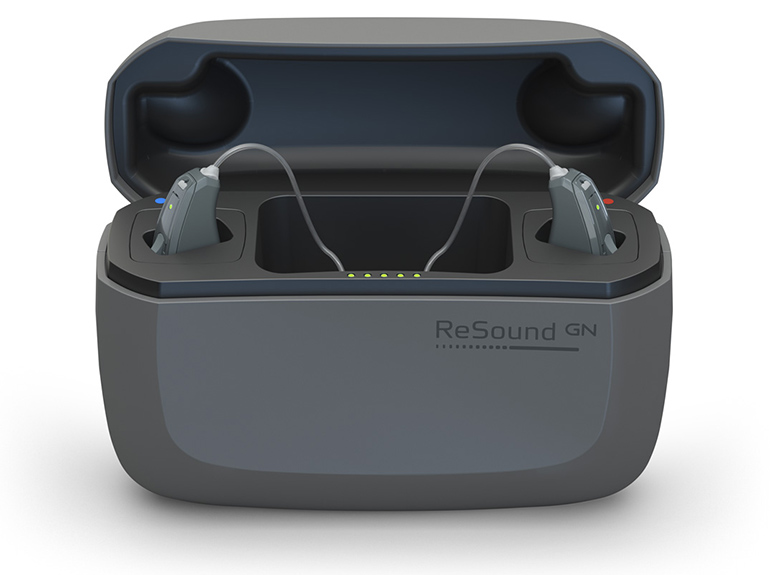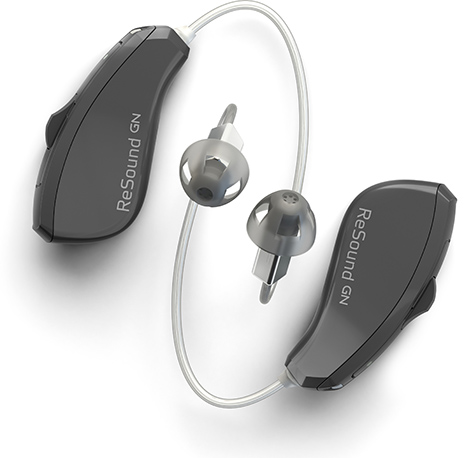
Modern hearing aids have to pack a great deal of technology in a tiny package. The batteries, high speed computer chips, speakers, microphones, and antennas have to all fit together and work in unison. They drive multiple sound processing algorithms that can modify how audio is boosted for the unique needs of each individual user. They can connect to other devices, such as TVs and in-car audio systems, and so interact and communicate with others.
GN Hearing, a Danish company, is one of the world’s largest manufacturers of hearing aids, best known for the ReSound brand, but they also make the very popular line of Jabra ear buds. We recently had a chance to ask Laurel Christensen, Chief Audiology Officer at GN Hearing, more about the technology inside of the devices that her company manufactures.
Medgadget: Hearing aids have come a long way over the decades and the technology within them continues to improve rapidly. Can you give us a sense of what has become possible over the last few years and what capabilities you think hearing aids will have in the future?
Laurel Christensen, Chief Audiology Officer, GN Hearing: There is no doubt that hearing aids have completely changed, even in the last 10 years. Everything from the quality, functionality and even the look has changed dramatically, allowing people to seamlessly integrate hearing aids into their everyday life without hassle or embarrassment. There are many things that have become possible for hearing aid users. Today, you can connect them to a TV, iPhone or Android phone, wirelessly streaming anything from a phone call to music straight to your ears.
Additionally, the sound quality of today’s hearing aid is more natural than ever. Comparing the sound quality to even just a few years ago, the ability and level of personalization that is possible now was not possible then. Today, hearing aids are driven by an app, right on your phone, like your own personal remote control. The level of personalization also goes way beyond just adjusting the volume. Our hearing aids now use artificial intelligence (AI) to suggest an adjustment to the hearing aid wearer based on the environment. Users can now easily switch to their favorite restaurant setting before they even sit down just by using an app on their phone.
This advancement is just a beginning. We believe that applications of AI will increasingly be integrated into hearing care solutions to improve personalization and the overall hearing experience.

Medgadget: There are a variety of devices out there that help people to hear the world around them better, and yet they are not hearing aids. What is the difference and where is the line drawn?
Christensen: Looking specifically in the United States, people use PSAPs, or Personal Sound Amplification Products. There is an enormous difference between PSAPs and hearing aids. Hearing aids are FDA approved medical devices provided and serviced by a hearing care professional. PSAPs are not. In fact, these devices aren’t allowed to be advertised as a hearing aid, and don’t offer nearly the same sound quality, especially in noisy situations. They might amplify speech a little in a quiet environment, but they do not have the level of sophistication that hearing aids have today.
In the coming years, over-the-counter hearing aids will start becoming available in the United States. The FDA will finalize the rules around what these might entail, but they will likely be something closer to the hearing aids we have today but are only going to be meant for someone with mild to moderate hearing loss. This option will be better than a PSAP but won’t compare to what a true hearing aid system can provide. And they won’t come with professional care.
Medgadget: Why are hearing aids still considered expensive? What can be done to bring the cost down and improve access?
Christensen: Today’s hearing aids advancements come from extensive research and development, which, of course, comes with a cost. It isn’t simple to build a hearing aid. From signal processing to delivering speech and sound digitally to your ear has taken many years of research to help create solutions to help people hear. Hearing aids have come a long way from the linear amplifiers that you can just buy off the shelf. Extensive research and development also goes into the making of accessories, wireless connectivity and other features that make our hearing systems the most comprehensive on the market.
Because hearing is so essential to our health and quality of life, many people are willing to make an investment in their hearing aids. Of course, there are a range of costs for hearing aids depending on the model, the dispenser, the features, or if they are fit for you personally.
We also can’t forget that the cost of hearing aids often includes service and care of a trained hearing care professional.
The over-the-counter products coming to the United States will be aiming to expand access, but will be targeted to people who have more mild hearing loss than traditional hearing aid users. We don’t have these products on the market today, but we can assume that they will be less expensive, especially since they won’t come with the service and care of a hearing care professional.
Medgadget: What are the existing challenges to the adoption of hearing aids? How is technology helping on this issue?
Christensen: People associate getting a hearing aid with admitting you are old enough to get a hearing aid. No matter what hearing aids look like or how they change cosmetically, many still see it as having to accept aging.
Ultimately, the event that must occur for people to finally get a hearing aid is when they start missing important conversations in their lives. Whether it be their children or grandchildren speaking or what was said in an important business meeting, their quality of life is being impacted. It usually takes a little bit of pain for us to alter our lifestyle. People with mild hearing loss aren’t experiencing this pain yet and aren’t missing these important conversations yet, so they have yet to take the step toward adopting hearing aids. But hearing aids don’t have to be burdensome. Today’s sleek, discreet, high-tech solutions can improve hearing and allow people to hear the things that matter most.
Medgadget: What is the outlook for the industry? Is it possible for cheap, readily accessible technology powered by smartphones to eclipse traditional hearing aids?
Christensen: The outlook of the industry is extremely promising because of the life changing technology that we are able to make today. While there may be cheaper technology options out there, I don’t believe we’re ever going to see something eclipse today’s traditional hearing aid. There will always be a need for a true hearing aid system along with the benefits of working with a true hearing care professional.
Medgadget: Can you give us a sense of where GN Hearing is heading in the next few years and what technologies you’re researching?
Christensen: GN Hearing will continue down the path of where we have headed for many years, asking, “What are the problems that are still being experienced by those with hearing loss, and how can we work to solve those problems?”
Working with hearing care professionals and hearing aid users, GN Hearing is always looking for better solutions to improve hearing, especially in noisy environments. That’s the number one problem of people with hearing loss.
Everyone is talking about artificial intelligence (AI). This is an area we have already started to work. We are leveraging AI to personalize hearing care to a specific patient to give them a better hearing experience. Using machine learning and big data analysis, we are taking bigger steps to provide more automatic, natural and personalized solutions for each user.

Links: GN Hearing, ReSound, and Jabra…
